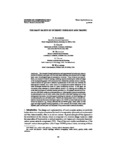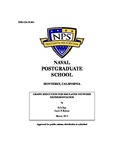Multilevel Resilience Analysis of Transportation and Communication Networks
| dc.contributor.author | Çetinkaya, Egemen K. | |
| dc.contributor.author | Alenazi, Mohammed J.F. | |
| dc.contributor.author | Peck, Andrew M. | |
| dc.contributor.author | Rohrer, Justin P. | |
| dc.contributor.author | Sterbenz, James P.G. | |
| dc.date.accessioned | 2018-09-18T19:05:30Z | |
| dc.date.available | 2018-09-18T19:05:30Z | |
| dc.date.issued | 2015 | |
| dc.identifier.citation | Multilevel Resilience Analysis of Transportation and Communication Networks. Egemen K. Çetinkaya, Mohammed J.F. Alenazi, Andrew M. Peck, Justin P. Rohrer, James P. G. Sterbenz, In Springer Telecommunication Systems Journal, vol. 60 iss. 4, December, 2015, pp. 515–537. (accepted July 2013) | en_US |
| dc.identifier.uri | https://hdl.handle.net/10945/59961 | |
| dc.description | Telecommunications Systems 60 (4), 515–537 | en_US |
| dc.description.abstract | For many years the research community has attempted to model the Internet in order to better understand its behaviour and improve its performance. Since much of the structural complexity of the Internet is due to its multilevel operation, the Internet’s multilevel nature is an important and non-trivial feature that researchers must consider when developing appropriate models. In this paper, we compare the normalised Laplacian spectra of physical- and logical-level topologies of four commercial ISP and two research networks against the US freeway topology, and show an- alytically that physical level communication networks are structurally similar to the US freeway topology. We also generate synthetic Gabriel graphs of physical topologies and show that while these synthetic topolo- gies capture the grid-like structure of actual topologies, they are more expensive than the actual physical level topologies based on a network cost model. Moreover, we introduce a distinction between geographic graphs that include degree-2 nodes needed to capture the geographic paths along which physical links follow, and structural graphs that eliminate these degree-2 nodes and capture only the interconnection properties of the physical graph and its multilevel relationship to logical graph overlays. Furthermore, we develop a multilevel graph evaluation framework and analyse the resilience of single and multilevel graphs using the flow robustness metric. We then confirm that dynamic routing performed over the lower levels helps to improve the performance of a higher level service, and that adaptive challenges more severely impact the performance of the higher levels than non-adaptive challenges. | en_US |
| dc.description.sponsorship | This research was supported in part by NSF FIND (Future Internet Design) Program under grant CNS-0626918 (Post- modern Internet Architecture), NSF grant CNS-1219028 (Re- silient Network Design for Massive Failures and Attacks), by NSF grant CNS-1050226 (Multilayer Network Resilience Analysis and Experimentation on GENI), by the EU FP7 FIRE Programme ResumeNet project (grant agreement no. 224619), and by the Battelle Institute under contract number NFP0069666: Interdomain Resilience | en_US |
| dc.rights | This publication is a work of the U.S. Government as defined in Title 17, United States Code, Section 101. Copyright protection is not available for this work in the United States. | en_US |
| dc.title | Multilevel Resilience Analysis of Transportation and Communication Networks | en_US |
| dc.type | Article | en_US |
| dc.contributor.department | Computer Science (CS) | |
| dc.subject.author | Internet modelling | en_US |
| dc.subject.author | critical infrastructure | en_US |
| dc.subject.author | attack | en_US |
| dc.subject.author | graph spectrum | en_US |
| dc.subject.author | flow robustness | en_US |
| dc.subject.author | algebraic connectivity, spectral radius | en_US |
| dc.subject.author | network science | en_US |
| dc.subject.author | Gabriel graph | en_US |
| dc.subject.author | geographic graph | en_US |
| dc.subject.author | structural graph | en_US |
| dc.subject.author | multilevel graph | en_US |
| dc.subject.author | network cost | en_US |
| dc.subject.author | resilience | en_US |
| dc.subject.author | survivability | en_US |
| dc.subject.author | dependability | en_US |
| dc.subject.author | performability | en_US |
| dc.description.funder | This research was supported in part by NSF FIND (Future Internet Design) Program under grant CNS-0626918 (Post- modern Internet Architecture), NSF grant CNS-1219028 (Re- silient Network Design for Massive Failures and Attacks), by NSF grant CNS-1050226 (Multilayer Network Resilience Analysis and Experimentation on GENI), by the EU FP7 FIRE Programme ResumeNet project (grant agreement no. 224619), and by the Battelle Institute under contract number NFP0069666: Interdomain Resilience | en_US |





